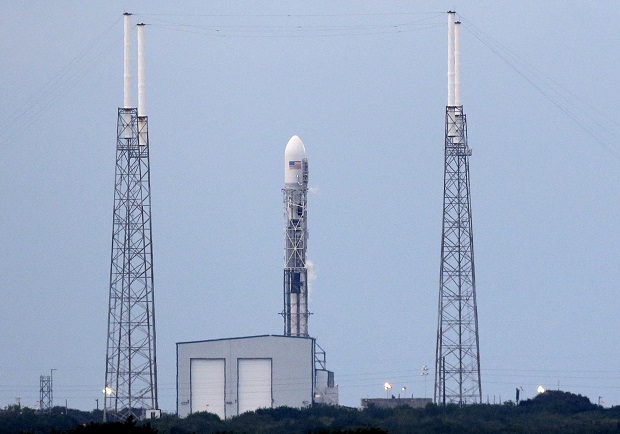SpaceX launches observatory on 3rd try, nixes landing test

A Falcon 9 SpaceX rocket stands on launch complex 40 moments after the launch attempt was scrubbed because of upper level winds at the Cape Canaveral Air Force Station in Cape Canaveral, Fla., Tuesday, Feb. 10, 2015. AP
CAPE CANAVERAL, Florida—SpaceX launched an observatory inspired by former Vice President Al Gore toward a solar-storm lookout point a million miles away Wednesday.
The unmanned Falcon 9 rocket blasted off on the third try in four days, successfully hoisting the spacecraft for Nasa, the National Oceanic and Atmospheric Administration (Noaa) and Air Force.
Gore — who dreamed up the idea for an environmentally conscious, Earth-gazing satellite 17 years ago — returned for the sunset launch. He was at the previous two attempts as well, eager to see his brainchild finally soar. Besides watching for solar outbursts, the observatory will provide continuous pictures of the full, sunlit side of Earth.
It “will give us a wonderful opportunity to see the beauty and fragility of our planet,” Gore said in a statement. He said he was grateful to all the scientists and others who saw the mission to completion.
Unlike Tuesday, the wind stayed within safety limits and everything else went SpaceX’s way — at least for launch.
But rough seas forced the company to cancel its effort to land the leftover booster on an ocean platform.
Waves towering three stories high crashed over the landing-zone platform floating 370 miles (595 kilometers) off the Florida coast. Making matters worse, one of four engines needed to keep the platform steady was not working.
With three hours remaining in the countdown, SpaceX called off the radical landing test of the first-stage booster. It would have been just the second such experiment; last month’s try ended in flames when the booster slammed into the platform, fell over and exploded.
“Mega storm preventing droneship from remaining on station, so rocket will try to land on water,” SpaceX chief Elon Musk reported via Twitter shortly before liftoff. He said the chance of it surviving was less than 1 percent.
Musk later said the rocket landed in the ocean within 10 miles (16 kilometers) of the target — and “nicely vertical!” Its descent was slowed by a pair of engine firings, with steering by fins attached to the booster.
The launch was unaffected by the cancellation of the test, a secondary, personal objective for Musk, SpaceX’s billionaire founder.
Sending the observatory on its $340 million mission was the main event. It represented the first deep-space mission for the Southern California company, which also delivers supplies to the International Space Station and aims to haul astronauts as well in two years.
Nasa and Noaa pulled the sacked satellite out of storage nearly a decade ago, and retooled it to monitor solar outbursts while also measuring ozone in Earth’s atmosphere and changes in the planet’s radiation. Originally named Triana after the Christopher Columbus lookout who first spotted the New World, the observatory is now nicknamed DSCOVR (pronounced discover).
DSCOVR will spend nearly four months traveling 1 million miles (1.61 million kilometers), four times farther than the moon, to the so-called Lagrange point, a gravity-neutral position in direct line with the sun. At this lookout location, 92 million miles from the sun, it will provide advance warnings of incoming geomagnetic storms that could disrupt power and communications on Earth, beginning around midsummer.
A 17-year-old Nasa satellite, ACE for Advanced Composition Explorer already is at the Lagrange or L-1 point, and DSCOVR will take over as the main solar-storm sentry, according to Noaa.
The steady stream of Earth pictures, meanwhile, is expected to be high on the “wow” factor. The observatory’s camera will provide the first snapshots of the entire home planet, its full face lit by the sun, since NASA’s final Apollo moon-landing in 1972. Subsequent Earth views have been stitched together from multiple images.
As for the scrubbed booster-landing test, SpaceX said there will be many other opportunities this year.
The first and only platform landing attempt to date occurred Jan. 10. The first-stage booster ran out of hydraulic fluid too soon and slammed into the platform, falling over and exploding.
SpaceX added extra hydraulic fluid for the guidance fins this time. But Musk and others warned the landing would be harder to nail because of the booster’s higher incoming speed from 80 miles (128.74 million kilometers) up.
Musk wants to start retrieving and reusing his rockets to save time and money. First-stage boosters normally just slam into the Atlantic and sink.
SpaceX just signed a lease with the Air Force for an old launch pad that will be converted into a landing pad.